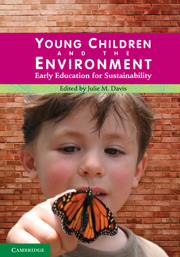Book contents
- Frontmatter
- Foreword
- Contents
- List of contributors
- Introduction
- PART 1
- PART 2
- Chapter 6 Repositioning an ethic of sustainability in early childhood education, with Reconciliation as central
- Chapter 7 The world is flat: ICT and education for sustainability in the early years
- Chapter 8 Healthy and sustainable environments for children and communities
- Chapter 9 Creating deep and broad change through research and systems approaches in early childhood education for sustainability
- Endnote
- Index
- References
Chapter 9 - Creating deep and broad change through research and systems approaches in early childhood education for sustainability
from PART 2
- Frontmatter
- Foreword
- Contents
- List of contributors
- Introduction
- PART 1
- PART 2
- Chapter 6 Repositioning an ethic of sustainability in early childhood education, with Reconciliation as central
- Chapter 7 The world is flat: ICT and education for sustainability in the early years
- Chapter 8 Healthy and sustainable environments for children and communities
- Chapter 9 Creating deep and broad change through research and systems approaches in early childhood education for sustainability
- Endnote
- Index
- References
Summary
EDITOR'S NOTE
In this final chapter, Jo-Anne Ferreira and Julie Davis raise two matters they consider essential for the future development of ECEfS. The first is the need to create deep foundations based in research. At a time of increasing practitioner interest, research in ECEfS is meagre. A robust research community is crucial to support quality in curriculum and pedagogy, and to promote learning and innovation in thinking and practice.
The second ‘essential’ for the expansion and uptake of EfS is broad systemic change. All levels within the early childhood education system – individual teachers and classrooms, whole centres and schools, professional associations and networks, accreditation and employing authorities, and teacher educators – must work together to create and reinforce the cultural and educational changes required for sustainability. This chapter provides explanations of processes to engender systemic change. It illustrates a systems approach, with reference to a recent study focused on embedding EfS into teacher education. This study emphasised the apparent contradiction that the answer to large-scale reform lies with small-scale reforms that build capacity and make connections.
INTRODUCTION
Most education policymakers are unaware of the scale of change required if education is to help achieve a sustainable society (Sterling, 2006). This is particularly so for early childhood education, which has come late to the environmental and sustainability agenda. This final chapter brings together themes and perspectives from the previous chapters, with special emphasis on the need for change within the early childhood education sector – changes in the ways we think, learn, teach and act.
- Type
- Chapter
- Information
- Young Children and the EnvironmentEarly Education for Sustainability, pp. 273 - 293Publisher: Cambridge University PressPrint publication year: 2010
References
- 5
- Cited by



